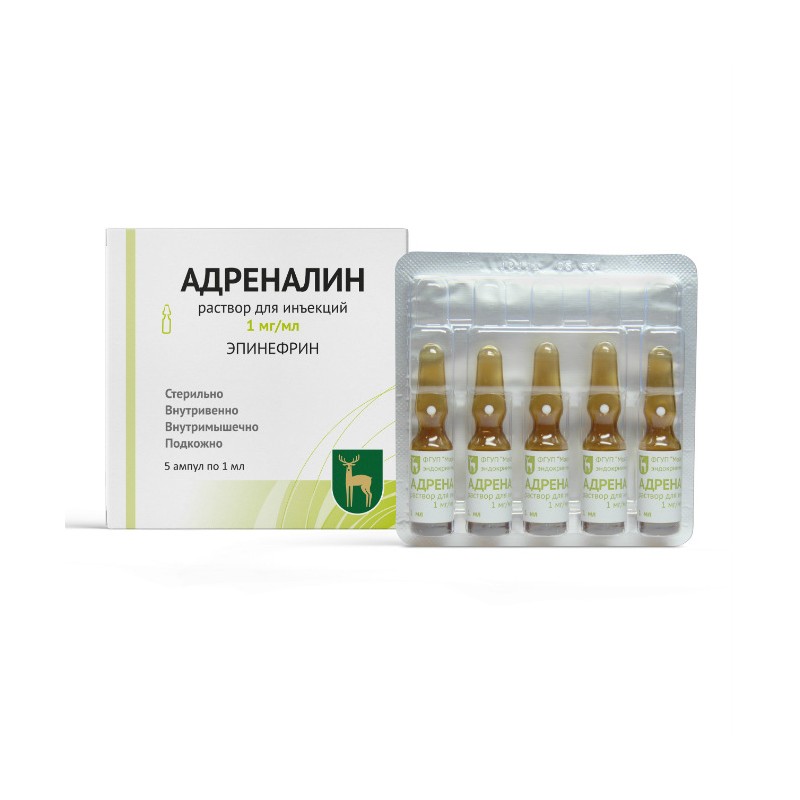




Security policy (edit with Customer reassurance module)

Delivery policy (edit with Customer reassurance module)

Return policy (edit with Customer reassurance module)
Compound
1 ml of solution contains:
Active substance: epinephrine 1 mg
Excipients: sodium chloride, sodium metabisulfite, chlorobutanol hydrate, ethylenediaminetetraacetic acid disodium salt (disodium edetate), glycerin (glycerol), hydrochloric acid solution 0.01 M.
topical solution
Colorless or slightly colored transparent liquid with a characteristic odor.
Alpha and beta adrenostimulating agent. At the cellular level, the action is due to the activation of adenylate cyclase on the inner surface of the cell membrane, an increase in the intracellular concentration of cyclic adenosine monophosphate and calcium ions.
Acting on alpha-adrenergic receptors located in the skin, mucous membranes and internal organs, it causes vasoconstriction, a decrease in the rate of absorption of local anesthetics, increases the duration and reduces the toxic effect of local anesthesia.
Bleeding from superficial vessels of the skin and mucous membranes, incl. from the gums.
Symptoms: excessive increase in blood pressure, tachycardia, alternating with bradycardia, rhythm disturbances (including atrial and ventricular fibrillation), coldness and pallor of the skin, vomiting, headache, metabolic acidosis, myocardial infarction, craniocerebral hemorrhage (especially in elderly patients), pulmonary edema, death.
Treatment: stop using the drug, symptomatic therapy - to lower blood pressure - alpha-blockers (phentolamine), with arrhythmia - beta-blockers (propranolol).
From the side of the cardiovascular system: less often - angina pectoris, bradycardia or tachycardia, palpitations, increase or decrease in blood pressure, at high doses - ventricular arrhythmias, rarely - arrhythmia, chest pain.
From the nervous system: more often - headache, anxiety, tremors, less often - dizziness, nervousness, fatigue, psychoneurotic disorders (psychomotor agitation, disorientation, memory impairment, aggressive or panic behavior, schizophrenia-like disorders, paranoia), sleep disturbance, muscle twitching.
From the digestive system: more often - nausea, vomiting.
From the urinary system: rarely - difficult and painful urination (with prostatic hyperplasia).
Allergic reactions: angioedema, bronchospasm, skin rash, erythema multiforme.
Others: rarely - hypokalemia, less often - increased sweating
Epinephrine antagonists are alpha- and beta-adrenergic receptor blockers. Weakens the effects of narcotic analgesics and hypnotics. When used simultaneously with cardiac glycosides, quinidine, tricyclic antidepressants, dopamine, means for inhalation anesthesia (chloroform, enflurane, halothane, isoflurane, methoxyflurane), cocaine increases the risk of arrhythmias (together they should be used with extreme caution or not at all), with other sympathomimetic means - an increase in the severity of side effects from the cardiovascular side, with antihypertensive drugs (including diuretics) - a decrease in their effectiveness.
Simultaneous administration with monoamine oxidase inhibitors (including furazolidone, procarbazine, selegiline) can cause a sudden and pronounced increase in blood pressure, hyperpyretic crisis, headache, cardiac arrhythmias, vomiting, with nitrates - a weakening of their therapeutic effect, with phenoxybenzamine - an increase in the hypotensive effect and tachycardia, with phenytoin - a sudden decrease in blood pressure and bradycardia, with preparations of thyroid hormones - mutual enhancement of the action, with drugs that prolong the QT interval (including astemizole, cisapride, terfenadine) - prolongation of the QT interval, with diatrizoates, iothalamic or yoxaglic acids - an increase in neurological effects, with ergot alkaloids - an increase in the vasoconstrictor effect (up to severe ischemia and the development of gangrene).
Reduces the effect of insulin and other hypoglycemic agents.
Topically: to stop bleeding in the form of tampons moistened with a solution of the drug.
Symptoms: excessive increase in blood pressure, tachycardia, alternating with bradycardia, rhythm disturbances (including atrial and ventricular fibrillation), coldness and pallor of the skin, vomiting, headache, metabolic acidosis, myocardial infarction, craniocerebral hemorrhage (especially in elderly patients), pulmonary edema, death.
Treatment: stop using the drug, symptomatic therapy - to lower blood pressure - alpha-blockers (phentolamine), with arrhythmia - beta-blockers (propranolol).
Easily destroyed by alkalis and oxidizing agents.
If the solution has acquired a pinkish or brown color or contains sediment, it cannot be used. The unused portion should be destroyed.
Solution for topical application 0.1%.
On prescription
List B. In a place protected from light, out of the reach of children, at a temperature not exceeding 15 C.
3 years. Do not use after the expiration date printed on the package.